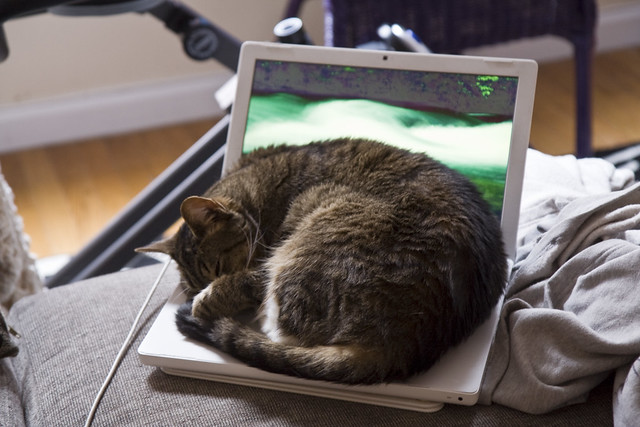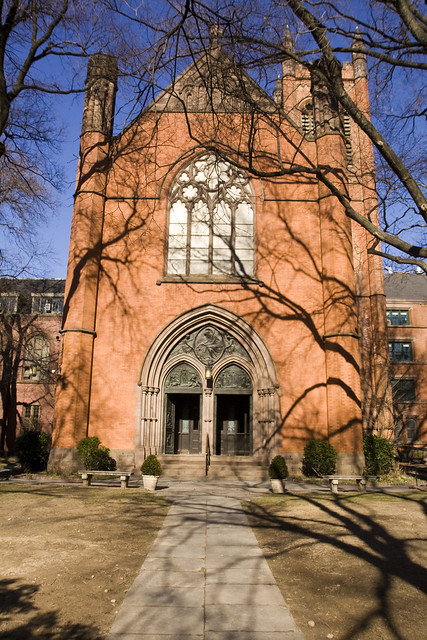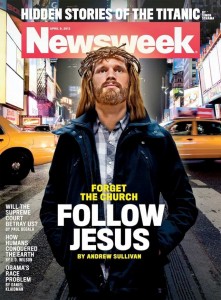
My Apartment, New York City. March 14, 2012
365 Part Deux

 I think, maybe, just maybe, I had my first seminary dream about General Seminary last night. I’m not sure how the dream started and I don’t think my seminary was the point of the dream at all but, there it was, hanging out. However, GTS wasn’t located where it usually is in Chelsea; nor was the entire campus there. Rather, the front of the chapel was located in my neighborhood of Washington Heights. And, not only that, it was not really a chapel anymore. It had become one of those storefronts where the merchandise spills out into the street and the entire front is covered in clothes hanging from hangers. And the front was entirely black because it was covered in cassocks. They had cassocks of all sizes! Small, large, child-size, etc. I think there was even a cassock spanx option and, I kid you not, they even had those half mannequins, the ones that are just legs but have some extra room in the back (if you know what I mean) to model jeans, with cassocks on them. Cars, taxies, traffic, and people were wizzing by as I stopped to take a look. My friend Anne came out to talk to me, and several of my friends were moving cassocks from one spot to another. I don’t think they were actually trying to sell anything – they were just moving things up, down, left, right, and using that giant hook to reach the top hangers. And the chapel even had its own awning with pigeons walking along it.
I think, maybe, just maybe, I had my first seminary dream about General Seminary last night. I’m not sure how the dream started and I don’t think my seminary was the point of the dream at all but, there it was, hanging out. However, GTS wasn’t located where it usually is in Chelsea; nor was the entire campus there. Rather, the front of the chapel was located in my neighborhood of Washington Heights. And, not only that, it was not really a chapel anymore. It had become one of those storefronts where the merchandise spills out into the street and the entire front is covered in clothes hanging from hangers. And the front was entirely black because it was covered in cassocks. They had cassocks of all sizes! Small, large, child-size, etc. I think there was even a cassock spanx option and, I kid you not, they even had those half mannequins, the ones that are just legs but have some extra room in the back (if you know what I mean) to model jeans, with cassocks on them. Cars, taxies, traffic, and people were wizzing by as I stopped to take a look. My friend Anne came out to talk to me, and several of my friends were moving cassocks from one spot to another. I don’t think they were actually trying to sell anything – they were just moving things up, down, left, right, and using that giant hook to reach the top hangers. And the chapel even had its own awning with pigeons walking along it.
The Chapel of the Good Shepherd as a literal storefront church – that would be pretty wild. I don’t think of mainline protestant churches as storefronts. Even the storefront churches in my neighborhood are being closed down and transformed back into restaurants, stores, and condos. The very idea of a “storefront church” seems rather foreign in a neighborhood that is being gentrified. But it would be wild to take the seminary’s chapel, a chapel that is designed to perform the daily office, and that is locked inside the fortress walls of General Seminary, and put it right out there, on the street, so that anyone could access it. It seems that every week, as I leave seminary, someone on the street and speaks to me that they didn’t know a church was there until they heard the chimes. People don’t really look up, they don’t see signs labeling the building or the entrances; something needs to catch their eye or their ears and intrude into their iPod/iPhone earbud shielded worlds. I wonder if a storefront full of black cassocks, on a Good Friday, when the sky is darkened as Jesus’ breathed his last on the cross – I wonder if all that pious black, would somehow crack into a random passerby’s world, just for a moment, or if, being New Yorkers, we’d need a little more – like some chimes, a loud cry, or maybe a Mr. Softie Ice Cream truck – church style. Hmmm. I don’t know. But a Mr. Softie Ice Cream truck playing A Mighty Fortress is My God might get noticed.
 It seems that Time Magazine didn’t want to let Newsweek be the only one to talk about Jesus this week. Rethinking Heaven is Time’s foray into eschatology. I wish I could read the whole thing but I’m not a subscriber. The cover enticed me and, I’ll admit, I want that guys shoes. However, the Politico Playbook felt like sending out a teaser today.
It seems that Time Magazine didn’t want to let Newsweek be the only one to talk about Jesus this week. Rethinking Heaven is Time’s foray into eschatology. I wish I could read the whole thing but I’m not a subscriber. The cover enticed me and, I’ll admit, I want that guys shoes. However, the Politico Playbook felt like sending out a teaser today.
Heaven Can’t Wait: Why rethinking the hereafter could make the world a better place”: “Angels and harps are all well and good, [some younger] Christians believe, but fighting HIV/AIDS is more urgent. This younger generation is driven by … issues of social justice like combatting slavery and homelessness. … The debate doesn’t fit easily on the usual left-right, blue-red, liberal-conservative spectrum. … The divide isn’t about a secular ideal of service vs. a religiously infused vision of reality. It’s about whether believing Christians see earthly life as inextricably bound up with eternal life or as simply a prelude to a heavenly existence elsewhere. …
“I’m a Christian-a poor one, to be sure-who keeps the feast and says his prayers . For me, the scholarly redefinition of heaven as a manifestation of God’s love on earth … at once puts believers in closer proximity to the intent of the New Testament authors and should inspire the religious to open their arms more often than they point fingers. Heaven thus becomes, for now, the reality one creates in the service of the poor, the sick, the enslaved, the oppressed. It is not paradise in the sky but acts of selflessness and love that bring God’s sacred space and grace to a broken world suffused with tragedy until, in theological terms, the unknown hour when the world we struggle to piece together is made whole again.”
Now, I know that this is a generalized news magazine and, based on the quote above, I’m pretty sure that they’re arguing for a scholarly redefinition of heaven that is based, largely, on what is going around in “Evangelical” circles ever since Rob Bell wrote his book last year. “Evangelicals” seem to make a lot of noise so and they seem to have numbers, so they get the articles. But I’m having a hard time seeing how this redefinition of heaven is “new.” I’m currently reading Carl Braaten’s Eschatology and Ethics for my Ethics class and his book, in many ways, is about a basic definition of eschatology where the future is breaking into the current world. It is an eschatology grounded in the gospel of Jesus Christ which “announces the future with the power to shape the present(pg. 70).” And this idea isn’t new. Braaten’s book was written in 1972 and I’m sure that Luther, and Augustine, wrote similarly. My guess, in many ways, is that Time’s new article is a story on the re-structuring of what The Book of Revelation says. It sounds like the article is going to report that young Christians, now, are not buying into the escapism that dominated the conversation, in certain Christian circles, for so long. And, sure, I could easily attack the line about creating heaven on earth but I’m gonna give the quote the benefit of the doubt and let it slide because, well, I don’t have the full article.
It was well planned to leak or release this article on Maundy Thursday. Later this evening, I will gather with my fellow Christians at my field site and we will wash each other’s feet. We will share in Holy Communion and we will, at least briefly, share in Christ’s service. At the end of the service, the altar will be stripped, and the lights lowered as we begin the walk into Good Friday. A rethinking of heaven, grounded in a “realized eschatology” grounded on…something…, could be linked to the act that we commemorate today in our liturgy. But I wonder if this article is going to miss the boat when it comes to mainline churches, especially us Lutherans. I’m pretty young, and I haven’t been in this church for decades, but this image of eschatology appears to play a role in what the Lutheran church has done for many, many years. Luther’s cry for all of us to be “little Christs” to one another is a cry that hasn’t just been rediscovered now. And I hope that little bit shows up in the article. If it doesn’t, then that might be a sign that us Lutherans need to do a better PR job.



 I know I shouldn’t read Andrew Sullivan. I know that I disagree with most of what he writes and, to be honest, his most recent editorial about Christianity is no different. He feels the need to jump on the Jefferson bandwagon and mistake Jefferson’s Americanizing of Jesus as, somehow, anti-political-power. Jefferson’s Jesus is not an exaltation of Jesus but rather a reduction of Jesus into a time specific, American, identity. Jefferson’s legacy, when it comes to Jesus, is to do what America does all the time about Jesus – molding Jesus into what they project onto the Jesus project. Jesus doesn’t break into the world but, rather, Jesus is a product of an idealized, American world.
I know I shouldn’t read Andrew Sullivan. I know that I disagree with most of what he writes and, to be honest, his most recent editorial about Christianity is no different. He feels the need to jump on the Jefferson bandwagon and mistake Jefferson’s Americanizing of Jesus as, somehow, anti-political-power. Jefferson’s Jesus is not an exaltation of Jesus but rather a reduction of Jesus into a time specific, American, identity. Jefferson’s legacy, when it comes to Jesus, is to do what America does all the time about Jesus – molding Jesus into what they project onto the Jesus project. Jesus doesn’t break into the world but, rather, Jesus is a product of an idealized, American world.
That’s what really gets me about Sullivan. The argument for a simplified Christianity, a Jesus-focused Christianity, is an old argument. The Reformers of the 16th century pushed for that. The men and women who went into the desert pushed for that. The ancestors to current American Evangelicalism pushed for that. Hell, pietism and my pal Henry Muhlenberg pushed for that. What Sullivan is arguing is a return to what Spener wanted in the 17th century – a visualized, simplified, transformative Christianity that is visibly seen in the church. The true church, then, is the church of Jesus! Simplicity! That’s the key to thing. Even Sullivan’s argument about Francis is all about simplicity. His argument is that Christianity is overload, too political, and too influenced by “worldliness.” Sullivan sounds like many of the young, hipster-esque non-denominational pastors out there but also sounds a lot like those who feel that Jesus wasn’t divine but, rather, a moral teacher. The idea is to strip Christianity back to Jesus – with the assumption that we, unlike the disciples in Mark, get it and we know even better than Peter, John, James, and Paul.
But here’s where Sullivan really blows it and that’s with the statement “As Jesus was without politics, so was Francis.” What? Or how about “When politics is necessary, as it is, the kind of Christianity I am describing seeks always to translate religious truths into reasoned, secular arguments that can appeal to those of other faiths and none at all.” Or, better yet, let’s make silly arguments and throw out parts of the gospel story by claiming that the patrons in Luke and Paul didn’t exist: “Jesus, like Francis, was a homeless person, as were his closest followers. He possessed nothing‚Äîand thereby everything.” All of this is, in reality, unscriptural. It’s a reduction of the complex reality of the what the scriptures are. It also tries to remove the current church, or argue that the crisis in the church can be resolved by removing itself out of its reality and where it is. By excising true Christianity from the rest of reality, true change can occur, true love can flourish, and we can get everyone to like us. Or something like that.
What Sullivan should be arguing is the question that Christianity has been working out since Constantine converted: how does Christianity work when it is in a position of political power? Because we still HAVEN’T figured that out (though I think Two Kingdom’s theology gets that bit right :p). And it doesn’t matter if its right wing or left wing, social justice oriented or rapture-focused, any Christianity in a position of political power is going to find itself in a dangerous position because of the political reality and visions within the gospel itself. A reduction to just a “Jesus focused” reality won’t change that problem. And we know that won’t work because we’ve been trying to do that for two thousand years. Reducing our actions to just what Jesus did, or taught, or what we believe Jesus did or taught, in many ways, denies Sin. It denies the need for Christ to die. And it reduces faith. Removing complexity from Christianity, Jesus, and God does the opposite of what Sullivan claims he wants to do. It’s not about accepting mystery and burying complexity into the mist of “somewhere else.” It’s actually how we get ourselves off the hook from the troubling parts of scripture, the complexity of canon, and the complexity of our own history and story. And why should we deny that? The Gospel is bigger than our complexity; God is bigger than our own failures; and we should own it, and never, ever, runaway from it.

I know I’ve been avoiding talking about the Trayvon Martin murder in depth. The event was tragic, terrible, and I feel for the all the families of the victim. The amount of videos, press information, and criminal reports I’ve read about the event is staggering compared to how I usually follow events like these. I’m hoping an arrest is made and criminal charges are pressed on Zimmerman and I’m appalled at the blatant racism that has been displayed by many, many people. It’s a reminder, to me at least, of how far this country has yet to go in regards to racial acceptance.
Bishop Hanson’s message was right on target, I think, and I’ve heard that Martin’s death has been on the radar of faithful Christians all over the place. It’s discussion has caused some soul searching, empathy, and it seems to be in the air even if its impact might be minimal in some places. But I would like to share one suggestion to those in the church who would like to discuss this attack (and racial issues) in general: please don’t use the word “become” as in “what has our society become that allows this to happen?” Speaking for myself, that phrase just shuts me down. In that one simple word and thought, what I see is a romanticism of the past, a rejection of all the other cases of racial violence/discrimination that have happened over the years, and a misidentification of the fact that race in the United States is still a big deal. Discrimination is still a big deal. We, collectively, are not moving away from some golden age but, rather, we’re suppose to be on track towards something better. The amazing thing is not that such an event happened but, rather, that there has existed, and continues to exist, a systematic structure in our society’s very being that allows such a thing to happen. If you are speaking of the law and searching for the gospel, if you are trying to tell the church how the world truly is, focusing on that one act isn’t enough. The groundwork that led to such an event is bigger than that and is built into our very bones. That’s sin and that needs to be talked about, and not washed away under some assumed golden age that was in our recent past.
Today’s reading in the lectionary for Holy Week is John 12:1-11. “You always have the poor with you, but you do not always have me” Jesus said to the disciples after they complained about Mary’s anointing of Jesus’ feet. I’ll admit I’ve always struggled with what Jesus said. Even when I exegete it, contextualize the story, and reframe the discussion to argue that what Jesus is commenting on is the lack of faithfulness that the disciples have, I still always return to that phrase “you will always have the poor with you” and shudder. It’s always struck me as an un-hopeful phrase. We will always have the poor with us? Really? We’ll always have the rejected, the unwanted, those who we don’t want to belong? We’ll always have people that we will not invite to our table but that only Jesus will? Always? For all time? Sheesh. What kind of Messiah are you, then? Can’t you just go ahead and take care of it all, wipe the poverty, injustice, fear, from the world, and end the very idea of the poor? I know that the Old Testament told us to let the poor glean but you just marched into Jerusalem with palms and garments thrown on your path – can’t you do MORE?
Today, for me at least, what Jesus tells the disciples is how I’ll frame what the church needs to say about racial injustice in this country. Don’t romanticize the past and claim that the “poor” were never there. Don’t, also, claim that this will be a topic that we’ll ever NOT have to talk about. We don’t, really, live in a post-racial society. We don’t live in a post-class society. We don’t live in a post-gender society. We don’t live in a post-sexuality society. As a church, we need to be honest and keep describing how the world truly is. The world needs to be broken into, changed, and made right. And as we march through this Holy Week, towards the Cross, lets try to keep all of this in mind. We’re not re-enacting the passion story – we’re proclaiming it because it is still needed to be heard today.
Last night, I was a research assistant for Dr. Alex at Never Sleep Alone. The show is hosted by a friend of a friend and my friend rounds up folks who don’t mind asking strangers charged questions. When the questions are asked, the clipboard charts filled out, we seat fill and become the rowdy bunch to start off the show right.
We showed up at 10:30 pm and were directed to the dusty-under-construction-probably-filled-with-asbestos dressing room. We put our stuff down and mingled with the other two dozen interns and volunteers. It was great because several of the folks were friends I hadn’t seen in awhile. There were so many of us that we were broken up into groups. Some were sent to give out free champagne, while others were sent to mingle in the crowd and give out personal invites to sexy people to attend the after party. The rest of us were given a three minute orientation, a lab coat, told to make up a fake name, and sent out into the world with a clipboard, different colored masks, and a pocket full of show branded condoms. I named myself “Sam.”
I learned in CPE that it is never really is THAT awkward to walk into a room and ask complete strangers questions about their deepest spiritual fears, hopes, and thoughts. So it was really a piece of cake walking to random (usually inebriated) strangers, some on dates, some with friends, and asking if they’re looking to “make a sexual connection tonight.” The section I covered never really filled up (lots of no-shows) but I did chat with a dozen people or so. Some highlights are below:
When the room was covered in masks, we were finished; we dropped our lab coats back in the dressing room, and sat in for the show. I really got a kick out of seeing how the show worked, who did what, and trying to figure out why the show worked. To quote K, the show is the type of show where you get out of it what you put into it – and being a married man with a kidling on the way means I’m not really that into it. But I did clap, sing along, laugh, judge what people were wearing, and felt incredibly old because only a few of us knew the lyrics to the opening song from Nirvana (kids these days!) It was also amazing watching people fall over themselves to get on stage. This article from the NY Times in December hits all the bases. It is STILL amazing that there were no dull spots, no places where no one moves, and no places where someone outright rejected Dr. Alex. The show moves, is funny, and is moving to Saturday nights (which means I can’t intern it anymore). I had a good time though I’m starting to realize that my staying out to 2:30 am (and sleeping through my subway stop) is probably starting to peter out.